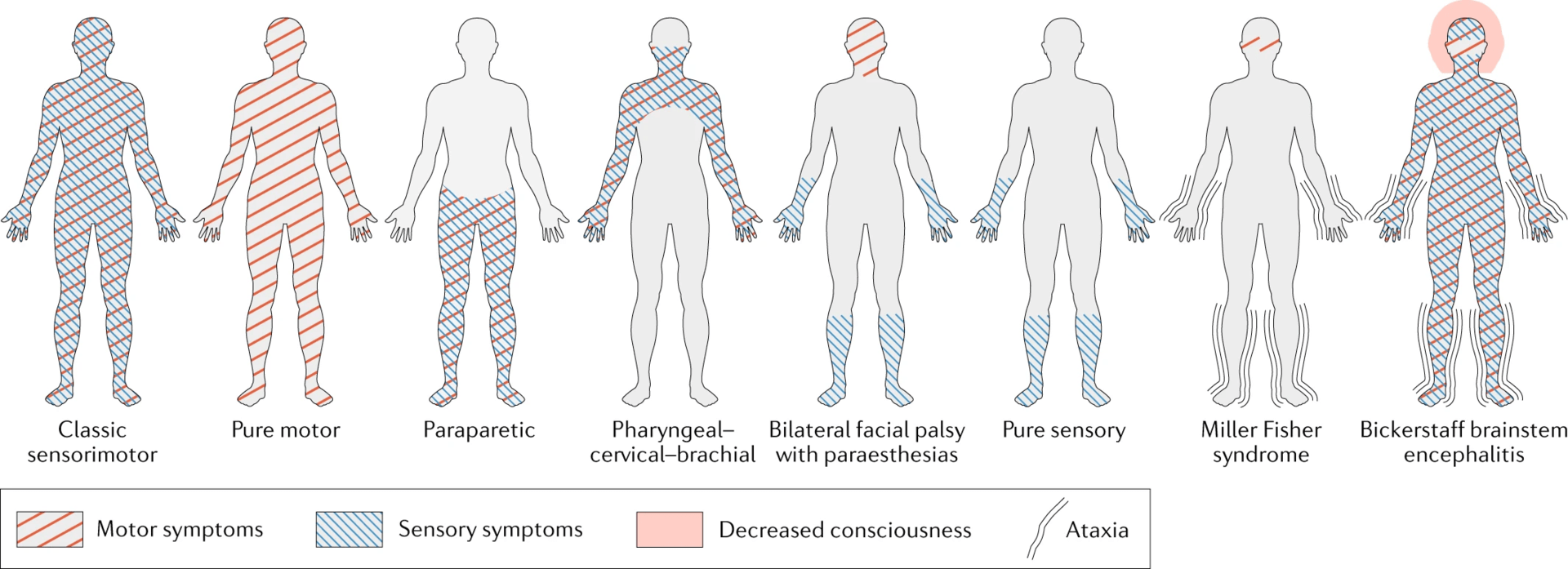What is the Difference Between Guillain Barre Syndrome and Myasthenia Gravis
Table of Contents
The key difference between Guillain Barre syndrome and Myasthenia gravis is that Guillain Barre syndrome is an autoimmune disease characterized by ascending paralysis and areflexia, often secondary to an infection, while Myasthenia gravis is an autoimmune disease characterized by weakness in specific muscle groups, especially ocular and bulbar muscles.
An autoimmune disease is a medical condition in which the immune system mistakenly attacks its own body cells. Normally, the immune system guards the own body cells against germs like bacteria and viruses. However, in autoimmune diseases, the immune system mistakes parts of the body like joints and skin as foreign and releases proteins called autoantibodies to attack healthy cells. Some well-known autoimmune diseases are type 1 diabetes, rheumatoid arthritis, psoriasis, multiple sclerosis, systematic lupus erythematosus, inflammatory bowel disease, Guillain Barre syndrome, and Myasthenia gravis.
CONTENTS
1. Overview and Key Difference
2. What is Guillain Barre Syndrome
3. What is Myasthenia Gravis
4. Similarities – Guillain Barre Syndrome and Myasthenia Gravis
5. Guillain Barre Syndrome vs Myasthenia Gravis in Tabular Form
6. Summary – Guillain Barre Syndrome vs Myasthenia Gravis
What is Guillain Barre Syndrome?
Guillain Barre syndrome is a rare autoimmune disease that is characterized by ascending paralysis and areflexia. In this medical condition, the body’s immune system attacks its own nerves. Weakness and tingling in the extremities are usually the first symptoms. These sensations can quickly spread eventually, causing paralysis in the whole body. In its severe form, Guillain Barre syndrome is a medical emergency. The exact cause is unknown. But most people with Guillain Barre syndrome have an infection in the six weeks preceding them. These infections include respiratory, gastrointestinal, or Zika virus.

Figure 01: Guillain Barre Syndrome
The symptoms of Guillain Barre syndrome may include prickling, pins and needles sensations in fingers, toes, ankles, or wrists, weakness in the legs that spread to the upper body, unsteady walking, difficulty with facial movements, double vision, severe pain that may feel achy, difficulty with bladder control or bowel function, rapid heart rate, low or high blood pressure, and difficulty breathing. Moreover, this condition can be diagnosed through medical history, physical examination, spinal tap (lumbar puncture), electromyography, and nerve conduction studies. Furthermore, treatment options for Guillain Barre syndrome include plasma exchange (plasmapheresis), immunoglobulin therapy, medication to relieve pain and prevent blood clots, and physical therapy.
What is Myasthenia Gravis?
Myasthenia gravis is an autoimmune disease that is characterized by weakness in specific muscle groups, especially ocular and bulbar muscles. Myasthenia gravis is characterized by weakness and rapid fatigue of any of the muscles under voluntary control. This is caused by a breakdown in the normal communication between nerves and muscles. In myasthenia gravis, the immune system produces antibodies that block or destroy many of the muscles’ receptor sites for a neurotransmitter called acetylcholine. Some researchers believe that the thymus gland triggers or maintains the production of antibodies that block acetylcholine. Moreover, some children have neonatal myasthenia gravis, and a hereditary form of myasthenia gravis called a congenital myasthenic syndrome.

Figure 02: Myasthenia Gravis
The symptoms of this condition may include muscle weakness, drooping of one or both eyelids, double vision, impaired speaking, difficulty swallowing, affect chewing, changing facial expressions, trouble walking, and difficulty in holding up the neck. Myasthenia gravis can be diagnosed through neurological examination, ice pack tests, blood analysis, repetitive nerve stimulation, single fiber electromyography (EMG), imaging (CT scan, MRI), and pulmonary function tests. Furthermore, the treatment options for myasthenia gravis are medications (cholinesterase inhibitors, corticosteroids, immunosuppressants), intravenous therapy (plasmapheresis, intravenous immunoglobulin, monoclonal antibodies), and surgery such as video-assisted thymectomy and robot-assisted thymectomy.
What are the Similarities Between Guillain Barre Syndrome and Myasthenia Gravis?
- Guillain Barre syndrome and Myasthenia gravis are two types of autoimmune diseases.
- Both conditions are rare.
- In both conditions, autoantibodies that attack normal healthy cells in the body are present.
- Both conditions may have similar symptoms.
- They are treated with specific medications and surgeries.
What is the Difference Between Guillain Barre Syndrome and Myasthenia Gravis?
Guillain Barre syndrome is an autoimmune disease characterized by ascending paralysis and areflexia, often secondary to an infection, while myasthenia gravis is an autoimmune disease characterized by weakness in specific muscle groups, especially ocular and bulbar muscles. Thus, this is the key difference between Guillain Barre syndrome and myasthenia gravis. Furthermore, Guillain Barre syndrome is caused by an autoimmune condition secondary to infection such as respiratory, gastrointestinal, or Zika virus. On the other hand, myasthenia gravis is caused by an autoimmune condition that blocks or destroys many of the muscles’ receptor sites for a neurotransmitter called acetylcholine.
The below infographic presents the differences between Guillain Barre syndrome and Myasthenia gravis in tabular form for side by side comparison.
Summary – Guillain Barre Syndrome vs Myasthenia Gravis
Autoimmune diseases are medical conditions where the body’s immune system attacks the healthy cells in the body by mistake. Guillain Barre syndrome and Myasthenia gravis are two autoimmune diseases. Guillain Barre syndrome is characterized by ascending paralysis and areflexia, often secondary to an infection, while Myasthenia gravis is characterized by weakness in specific muscle groups, especially ocular and bulbar muscles. So, this summarizes the difference between Guillain Barre syndrome and Myasthenia gravis.
Reference:
1. “Guillain-Barre Syndrome.” Mayo Clinic, Mayo Foundation for Medical Education and Research, 23 July 2021.
2. “Myasthenia Gravis.” Mayo Clinic, Mayo Foundation for Medical Education and Research, 22 June 2021.
Image Courtesy:
1. “Guillain Barre Patterns” By Leonhard, S.E., Mandarakas, M.R., Gondim, F.A.A. et al. – Diagnosis and management of Guillain–Barré syndrome in ten steps. Nat Rev Neurol 15, 671–683 (2019). https://doi.org/10.1038/s41582-019-0250-9 (CC BY 4.0) via Commons Wikimedia
2. “Wikipedia Project Myasthenia gravis” By Libbyspek – Own work (CC BY-SA 4.0) via Commons Wikimedia
ncG1vNJzZmivp6x7pbXFn5yrnZ6YsqOx07CcnqZemLyue9ahmK1lmah6tbTEZpuinpaav6a6wp5km52krLKmuoygrKKknJa2r3nBmqmrnV2oxq%2Bw0aiknmWRo7Fuudiaqq2glaO2onnGq5ivoaNk